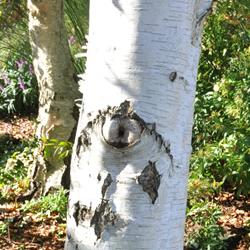Unusual bark can be a boon when it comes to adding interest to the garden, especially in the cool winter months when deciduous trees lose their leaves
Here are five of our favourite trees, suitable for both large and small gardens, all with unusual and beautiful bark.
1. Betula alba (Silver Birch)
These trees are often chosen for their eye-catching, silver-grey trunks. Tall and slim, they’re the answer for narrow alleyways in townhouse gardens and can be planted singly or in groups to resemble a mini-woodland.
Frost hardy, they thrive in cooler areas but are not happy in hot, dry gardens; water them regularly.
Size: 10m x 4m..jpg)
2. Lagerstroemia indica (Pride of India)
Smothered in huge panicles of delicate ‘crêpe’-textured flowers, crêpe myrtles or Pride of India, are an unforgettable sight when in full bloom. Their small stature and pretty bark makes them ideal for small gardens. When young, the bark has an incredible silky sheen then, as it ages, irregular pieces chip off revealing silver, grey, green and pink patches.
Relatively drought and frost tolerant, these deciduous trees should be cut back in winter for a better show of flowers in midsummer. Note: Mildew may be problematic during humid periods.
Size: 4–6m x 3–4m..jpg)
3. Acacia xanthophloea (Fever Tree)
What makes this tree so popular is not just its almost luminous, pale lime-green bark but its ability to grow in a wide range of climatic zones and soils – from sand to those which are periodically waterlogged. It was named fever tree by early explorers who seemed to succumb to malaria when camping nearby; not surprising as these trees naturally grow near water where mosquitoes breed.
Fast growers, they can take moderate frost and can be planted close together; position them where the sun will highlight their trunks.
Size: 8–15m x 4–6m..jpg)
4. Acacia sieberiana var. woodii (Paperbark Thorn)
Among the numerous trees known as ‘paperbarks’ this one, with its typical spreading, flat-topped crown, is most symbolic of Africa. Its major attraction is its striking paper-like layers of pale creamy to tan bark which children, and some adults, can’t resist peeling off. The bark provides shelter for a multitude of insects which in turn attract birds, as do the fluffy, creamy white ball-like flowers.
Half hardy and relatively waterwise, it’s an excellent choice for light shade in warmer regions.
Size: 6–8m x 7–14m..jpg)
5. Trees which often have attractive lichen patterns on their trunks
The grey trunk and branches of both the indigenous white stinkwood (Celtis africanus) and exotic C. sinensis are often patterned with lichens as are those of the Cape Chestnut (Calodendrum capense). With their spreading canopies they are suitable shade trees for larger gardens and attract birds and butterflies. The stinkwood’s leaves turn yellow in autumn before falling, allowing the sun into the garden in winter. Although the Cape Chestnut only starts flowering after five to seven years, the prolific bunches of stunning pink orchid-like flowers in midsummer are worth waiting for. In cool areas, the leaves colour in autumn.
Size: 5–10m.
Indigenous trees with interesting bark:
Trees with white bark: Cape Holly (Ilex mitis) and the lavender tree, Heteropyxis natalensis.
Peeling bark: Ochna arborea (Cape Plane).
Chunky bark: Waterberry (Syzygium cordata), Nuxia floribunda (Wild Elder, Forest Elder and Forest Nuxia), Bosvlier and Bolusanthus speciosus (tree wisteria).

